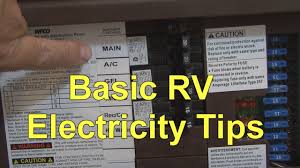Nothing is more frustrating than sitting comfortably in your RV and all of a sudden the lights go off, the TV goes off … nothing works. You check your breaker… nothing works. Now you contact the RV Park where you are staying. Did their electricity go off or is it just you?
Now you learn that you blew a breaker on their end. How is that possible and you are a little miffed that the RV Park didn’t supply the power required to handle your electric “load”.
But hold on just a minute. It might not be what you think. Living in and RV is not the same as living in a house. You are limited by your amperage as to how many things you can run at the same time. So let’s learn a little about your RV’s Electrical System and just how it all works together.
RV Electric 101
Having electric in your RV almost feels decadent. After all, many people call this camping but really, it’s like having a house – but on wheels. The ability to run a microwave, hair dryer, TV, toaster, espresso machine – even a washer/dryer – is brought to us by the magic of “shore power” (usually) or a 12-volt system with an inverter. In this article we’ll discuss electric derived from the post and plug.
Understanding Your RVs Electrical Systems
Amps Draw
It’s important to note that in an RV you can’t run several appliances at once or you’ll blow your breaker. Here’s the skinny. Your RV has either 30 amp or 50 amp capability. Amperage is the amount of power available to use. Each appliance pulls a specific number of amps. Exceed 30 or 50 amps (depending on your rig’s system) and poof – the power overloads and the breaker trips. Here’s a handy list of some of the typical appliances and the approximate amps required to operate them:
- Microwave 12.8 amps
- Air Conditioner – 15,000 BTU 12.5 amps
- Electric Water Heater – 6 gallon 12.5 amps
- Toaster 10 amps
- Hair Dryer 10 amps
- Electric Frying Pan 10 amps
- Electric Coffee Pot 10 amps
- TV 2 amps
- Crock Pot 1.5 amps
- Heating Pad .5 amps
Most electrical products note how many watts or amps it takes to operate them. If you only see watts divide the watts by 120 (volts) and you’ll have the amps. Reverse that – multiply amps by 120 (volts) and you’ll have the watts.
While amperage is the draw, voltage is the flow. Think of voltage as a river. If you’re canoeing down a dammed river you have to paddle a little harder to move along. If the river is free-flowing you don’t have to work as hard to get downstream. Acceptable voltage (at 110 to 127 with no load on the system) allows your appliances to run in an efficient and easy manner. Drop below 110 and your appliances must work harder, get hotter and suffer the possibility of failure. For instance, never operate your A/C when your voltage is below 106 (when it’s running) or you risk damaging the motor – a costly repair (or replacement).
Volts Flow
How do you know the volts flowing into your RV? Simple – test it. I might go a bit overboard but I hate the thought of an improperly wired or inadequately powered electric connection zapping my system. This is the very first thing I do when I arrive at a site in case the power’s unacceptable and I have to move. To start with, I use a polarity tester (a little plug with red and amber lights and a key telling me what combination of lights should or should not light up) to make sure the power is wired correctly. Next I use a digital volt meter (set on AC Volts) to check how much voltage is going between ground and hot, neutral and hot, and ground and neutral. It’s not as complicated as it seems. The first two numbers should read within a volt of one another and should be in the 110 to 127 range. The other reading should be less than 1 volt (0 is optimal). If anything’s off kilter I don’t plug in and head back up to the office for assistance – maybe a different site or for maintenance to come have a look. Sometimes it’s a loose wire, a worn out breaker or receptacle – sometimes it’s more serious.
At the very least, I recommend you do a polarity test outside and use a line voltage monitor plugged in to an indoor outlet to check the incoming volts.
Options
Other power options include using your 12-volt system with an inverter, a generator or even solar power. The bottom line is knowing what you require to camp comfortably and assuring you have an adequate energy supply. So fire up the electric espresso machine or make a cuppa over a campfire. After all, camping is what you make it!!
Articles You Might Like:
- RV Surge Protectors, Do I really Need One?
- 7 RV Tire Maintenance Tips to Prolong the Life of your RV Tires
- 10 Things to Consider When Choosing an RV Park
Did this article help? Please leave your comments below.

